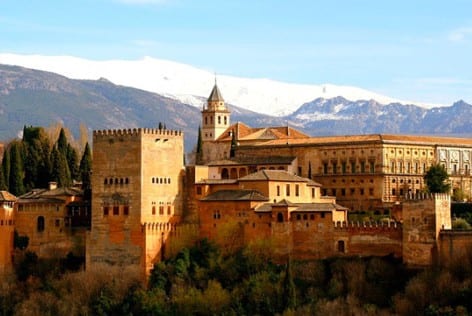IF you were to visit just one city in Spain, Ernest Hemingway wrote, it should be Granada – and there are few student cities to rival the undisputed capital of culture in Andalucia.
With multiple diverse higher education institutions, Spain’s largest student population soaks up the buzz beneath the inspiring skyline, dominated by the Alhambra.
And while the Moorish fort is the main sight to see, attracting 2.7 million visitors each year, there’s much more for students to explore.

Over 75,000 of the city’s 240,000 people are students and the University of Granada has been named as the most popular university in Europe for erasmus students.Youngsters are spoilt for choice between the courses on offer between the Universidad de Granada, the Escuela International de Gerencia and Escuela Superior de Arte y Diseño de Andalucia.
Students will be pleased to hear the party never truly ends in Granada – the celebrations are typically enjoyed all year round: from Theatre Festival at the end of May and the International Dance festival in June to winding down the year with the jazz festival in November.
The true highlight is Granada’s annual feria. Held every June, it’s a boozy, week-long celebration that takes place on a vast fairground – recinto – on the city’s outskirts and where women perform flamenco dancing and partygoers are fuelled by the feria signature drink of rebujito – mix of Manzanilla sherry and lemonade.
History
Historic Granada is imbued with the lessons of its forebears. The Moorish rule, between the 8th and 15th centuries, left its mark on the city with a sprawling fortress atop the Darro Valley. Originally dating from the 9th century, the fort and walls were extensively rebuilt in the 1200s by the Moorish ruler of what was then the Emirate of Granada, Mohammed ben Al-Ahmar. The last Moorish rulers of Granada the Nasrid Kings left behind their resplendent palaces built during the 13th and 14th centuries and featuring some of the Alhambra’s most intricate interiors.

The Granada poet Federico Garcia Lorca said: “If by the grace of God I become famous, half of that fame will belong to Granada, which formed me and made me what I am.” Lorca was assassinated by fascists in 1936 and today his life is commemorated at Huerta de San Vicente, his family’s summer house, which is open to the public for guided tours.
Must see
Realejo, Granada’s old Jewish quarter and the Sacromonte Gitano district are two of the city’s most charming and distinct neighborhoods, the streets and squares of which reward aimless meandering. Despite the tide of tourists to Granada, the cost of living is one of the lowest in Spain – and there are plenty of ways students can economise – not least because most bars offer a free tapa with every drink.
At weekends make time to explore the city’s ancient cobbled paths, full of bars and boutiques, or visit the Morroccan shops in Calle Caldereria Nueva and Calle Caldereria Vieja that Arab and Maghreb-style pastries, glittering lanterns and cushions adorned with sequins.
Granada’s Sacromonte district, just north of the Alhambra and east of the Moorish quarter of Albayzin, is home to the city’s thriving Roma (Gypsy) community. When classes are in session, a few cave dwellings will turn into discotecas and be packed with students at the weekend
And while you can’t beat watching the sunset from Mirador de San Nicolas, for the ultimate escape the adventurous can set off to Sierra Nevada for a weekend on the slopes.
Cost of living
Rent is notoriously inexpensive. One-bedroom flats cost between €450 to €600 a month while shared flats start at an average of €300. This is a student city and so discounts are guaranteed. Expat-owned Bar Poe offers huge plates of ‘exotic tapas’ for under a tenner, and popular Taberna Mercantil has plenty of potent wine to keep the students happy.
Nightlife
From traditional taps to karaoke in pubs and raves in caves, students have an overwhelming choice of nightlife in Granada. Sala Vogue kicks off the week playing indie pop-rock and techno across two dancefloors Monday to Sunday from midday until 6am.
Aliatar always has a full crowd, where DJs play unashamedly brash tunes in the converted cinema. For a more unusual night out, students head down to El Camborio in Sacromonte for flamenco dancers, live music and cheap drinks.
Culture
While the Alhambra is the main attraction – students are unlikely to get up at the crack of dawn to book tickets and dodge tourists. You can still see a great deal of the sprawling complex without stepping foot into the fortress itself – and penny-pinching students would do well to visit Generalife or the Carmen de los Martires Gardens.
For art lovers, the Museum of Fine Arts sits in the heart of the Charles V palace with over 2,000 incredible pieces of classic work. Elsewhere the Abadia del Sacromonte is the gypsy neighbourhood’s key historic site while the Museo Cuevas del Sacromonte shares the stories of the ancient gitano quarter.
Transport
Most of the city is accessible by foot and most students stick to the Calle Gran Capitan and San Juan de Dios, both in the university area, that come alive at nighttime.
The city’s main bus station is a little further out the centre but handles most services, including those to Sierra Nevada. Train tickets to Madrid and Barcelona start at €30, with stops to Cordoba, Zaragoza, Lleida and Tarragona.
Just 18km from the city centre, is Granada airport. Despite only having one terminal it has multiple airline providers including British Airways and direct flights to major destinations including Barcelona, Madrid, Bilbao, Ibiza, Menorca, Mallorca, Tenerife and Gran Canaria.
READ ALSO:
- EXCLUSIVE: PROTECTED VALLEY NEAR GRANADA IN SOUTHERN SPAIN FACES DESTRUCTION BY MOTORWAY AND NEW HOMES AFTER ADMINISTRATIVE BLIP
- Victory for the valley as Junta kick starts process to reclaim heritage status for Valle del Darro in Spain








